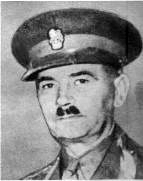|
Selecting the Troops The Royal Rifles of Canada
from Quebec City were under the command of Lt. Col. William
James Home. The Winnipeg Grenadiers were under the command of
Lt. Col. J.L.R. Sutcliffe. Both selected Battalions were placed
under the unified command of recently promoted Canadian
Brigadier J.K. Lawson of Ottawa, Ontario, who, by odd
coincidence, had been assigned the task of writing the combat
fitness reports on various units in the Canadian Army. He had
judged both the Royal Rifles and the Grenadiers as unfit. Now
... he was their Commanding Officer. |

Brigadier |
|
Basic Training The Royal Rifles of Canada and the Winnipeg Grenadiers had been trained in the use of the basic standard issue weapons available to the infantry at that time. Because of the nature of their posting, the Royal Rifles perhaps had a slight edge in training. Infantry training means getting to know your basic weapon inside and out. Soldiers took them apart, put them together again until it could be done blindfolded. Shooting their weapons was another story. Shooting live ammunition was ... expensive. No soldier in any army came out of basic training with a guarantee stamped on his forehead saying, "Under any battle conditions, even in the face of savage enemy fire, this soldier shall perform according to Military Specifications defining skills, and courage, and determination as outlined in K.R. Army, Section 007, or double the cost of training cheerfully refunded." It didn't happen then, and it doesn't happen now. A soldier was taught, "must
know, should know, and could know". He must know how to use, how
to maintain, and how to make minor repairs to his basic weapon,
his rifle. He should know about other weapons he would probably
have
to use: Bren guns, grenades, etc. He could know about weapons he
might come in contact with, Lewis guns, Vickers guns, or
mortars. Not every soldier in a platoon had to know everything
about every weapon the company might have in
its inventory. The Officers In the words of Rifleman John Beebe of "D" Company, Royal Rifles of Canada, No.18 Platoon: "I don't mind telling you right now, in the face of those stories about how badly trained, ill-equipped Canadian soldiers who were supposed to have been at Hong Kong, as far as our outfit went, that was a lot of nonsense. We had a tough fighting outfit, well led, and well trained. The training started in Sussex, and it kept right up." The Royal Rifles of Canada
amalgamated several militia units to create a viable force. The
Commanding Officer of the Regiment was Lt. Colonel William James
Home, M.C., E.D. a veteran of WWl who had been with the 8th
Royal Rifles in 1913 and had served with the Royal Canadian
Regiment, Canada's senior unit of the line from 1915 to 1940.
The Second in Command Lt. Colonel J.H. Price, an Artillery
officer who had volunteered to take a cut in rank to Major to
become a Company Commander in the RR of C. A total of 385
officers and men had left other units to form the new Regiment. ________________________________________ |
|
|
<<< Back |
Page 7 |
Next >>> |
|